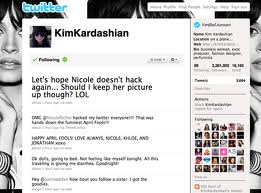News is never reported the day after anymore. You don’t have to patiently wait for the evening news or tomorrows paper to catch up on the latest stories. Briggs explains the phenomenon that has swept the Web: Microblogging.

- A microblogging service allows someone to publish small messages, usually no more than 140 characters, where you can use links to other Web sites, photos or videos. The most famously addictive Web site out of all the many microblogging sites would have to be Twitter. Ashton Kutcher first made this site a hit when he started tweeting a year or two ago. Soon teen girls around the country basically put their heads through the computer screen trying to follow Kutcher’s (or aplusk as he’s known in Twitter nation) daily tweets. The ease of publishing and the ease of consuming a message is the reason for microbloggings rapid growth over the past couple years.

I’d follow his Tweets.
*Another example of microblogging would be Facebook‘s status updates. The “What’s on your mind?” box has probably grown to be the most used feature on Facebook.
- Microblogging is quickly causing an information revolution. We get updates in real-time and, somtimes, we get the news straight from the source itself. Take Egypt for example, just a couple weeks ago the protesters in Tahrir Square tweeted their grievances, thoughts, ideas and protests to the world via Twitter and Facebook. When the government soon caught on and blocked Internet access to the country, Google and Twitter launched a service where Egyptians could call a certain number and leave a voicemail, then resulting in a Tweet that was recognized with “#egpyt.” Read the article here.
*To understand the world of Twitter, you must learn the language.
Tweet: A verb that meaning sending a message on Twitter, as a noun it means the message sent or received.
RT: Retweet, is when you copy someone else’s tweet and posting it so your followers can see it.
tworld: simply Twitter world
tweeples: those who use Twitter
This brings us to hashtags or simply “#.” They are used to mark key words or topics in a Tweet, ultimately creating a trend out of the word. (like the #egypt example used earlier)
Whether you hate it or embrace it, you can’t deny that Twitter and other microblogging sites are taking over the world. Literally. Kim Kardashian is reportedly being paid 10,000 USD to tweet to her followers about a product. If that kind of money doesn’t motivate you to create an account than I don’t know what will.








